SPECIAL REPORT: As the fireball enveloped him, Darren Hopkins prepared to die. He was 1800 feet in the air, his light plane engulfed in flames, and he could feel himself burning alive. With flames filling the cockpit and the windscreen glazed over, he knew he wasn’t going to make it. And yet, against all odds, he did.
In an extraordinary act of bravery, he forced the plane towards the ground, and dived headfirst out the door into a farm paddock carpeted with thick grass. He was found by the farmer’s wife – an emergency department nurse with 20 years’ experience.
Three years after that horrendous accident, the Tasmania Police inspector has returned to the skies, borrowing a mate’s plane for a short solo flight to conquer the fear and take wing again.
“It’s a milestone I’ve been heading towards for three years,’’ Hopkins, 54, said after returning to the hangar.
“It was a relief to get it done and it convinced me I’m ready to go back up flying by myself again. Just because I’ve had a near-death experience doesn’t mean I stop living.’’
The flight above Launceston Airport in northern Tasmania was uneventful, despite Inspector Hopkins fighting an intense bout of nerves as he took off.
He had to pass medical tests to prove his fitness as a pilot, and he had been on several flights as a passenger, but this was his first time alone in the cockpit since the fire which almost killed him on October 21, 2018.

FLAMES IN THE SKY
Hopkins had spent more than 700 hours flying the tiny two-seat Jabiru, which he’d assembled himself in the garage under his home, all over Australia without incident.
But on that Sunday, on a short joy flight around the Tamar Valley, he spotted a small fire in the footwell of the passenger seat, likely connected to a lithium-phosphate battery he had fitted to the plane.
Within seconds, flames and choking black smoke engulfed the cockpit, and as the windscreen and windows glazed over, Hopkins accepted he was going to die.
“I was flying blind, in a cockpit full of fire, 1800 feet above the ground,’’ he wrote several months after the accident.
“The flames engulfed the cockpit. It took 10 seconds at most. It had to be that the fuel lines had been burnt through by then. I had about 37 litres of aviation fuel on board. The fuel lines have fireproof sleeves over them but the fire was so aggressive, it had to be a fuel-driven fire.
“I could feel the heat start to burn my face and my legs. The flames were over my right hand which was on the controls near my thigh. I could feel my head burning.
“It was so hot and the fire was growing so fast and I thought, ‘OK, I am going to burn in the sky’. Even if I didn’t burn, I couldn’t see to land. At that point, I thought I was stuffed. I thought of my loved ones: my partner, Michelle, Mum and Dad, and my son, Mitch.
“I thought, ‘I’m gone, there’s nothing I can do about it’.
“I even thought, ‘Well, at least the family will be happy because I’ve gone doing something I love.’
“Then I thought, ‘When I do crash, I hope I don’t go into a house and hit anyone on the ground.’

“I sort of prepared myself for that. I had no control. There was nothing I could do that was going to help me.
“I was afraid. I was fearing death. I didn’t think I was going to make it, but I didn’t want to die. There was heat and there was pain. I knew I was physically on fire.
“I’ve had a few scrapes in my life. When I was shot back in 1996, I had thought, ‘Oh, this could be it, I’m going to die’ but I never actually felt death was inevitable back then.
“This time, I felt there was nothing I could do and I had just this feeling of hopelessness wash over me.
“Then I realised I was still flying the aircraft. My feet were on the rudder pedals. Right hand still on the controls, in the flames. Left hand wasn’t doing anything particularly but it was controlling the accelerator.
“I was still in charge of the aircraft, even if I couldn’t control the fire. All the control surfaces were working. The ailerons, the elevators, the rudder, everything was still functioning.
“My trusty little Jabiru was still flying and the engine didn’t miss a beat.
“I was still alive and I was still in control, so it was that point I thought, ‘Well, bugger it, I’m going to have a crack at getting this down’.
“And then that hopelessness was overtaken by a feeling of determination not to let it beat me.
“I put pain and that fear out of my mind. My mission was to put the aircraft down or die trying. I wouldn’t stop until the plane was falling apart, or had broken up, or I was consumed by the fire.’’
THE CRASH LANDING
Hopkins’ iPad survived the fire, and tracked what happened next, as he fought to control himself and the plane. It rose to 2000 feet, then dropped sharply towards the ground.
“I knew I couldn’t jump,’’ Hopkins wrote.
“I knew the odds were weighted against me. Most likely I was going to die.
“But I was absolutely determined to do everything I could to get out of the aircraft. I didn’t care if it was with broken bones: I could fix broken bones. But I couldn’t fix being burned alive.
“All I knew was I was going to have a crack at getting that thing down.
“So that’s what I did.
“I opened the side door and held it open with my left hand. There was a fair bit of wind resistance against the door but it did two things for me. It gave me a line of sight between the door hinges and the fuselage. A bit of a V-shape opened up and I thought, ‘That’s good, I can see the ground. I can see where I’m going’.
“The other thing it did was change the air flow in the aircraft, which gave me a reprieve from the heat around my face. My head was half out the door, the rest of my body was inside being cooked, but it gave my face a reprieve from the heat while I was descending.
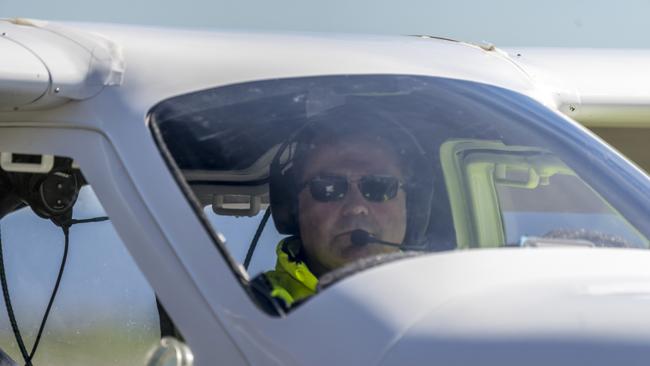
“I pretty much nosedived the plane. I could see a paddock ahead with green grass. It looked flat, not dead flat but I didn’t care. All that mattered was it didn’t have trees in it and it was away from houses.
“Normally when you’re landing the plane, you’d be looking for a nice long stretch of open ground, you’re slowing the aircraft down, putting on the flaps, and you’d position the plane into the wind to slow it down even more.
“All that went out the window. I just had to get down as quickly as I could onto anything that I had some hope of landing on, and getting out of the fire. I didn’t set the aircraft up at all. The only thing I did was to pull off the accelerator as I was landing … then just nosedived and made sure it was all off when I hit the ground.
“The farmer, I’ve got to thank him. He was growing some nice, lush grass for his hay later. His paddock looked as good as any, and it turned out to be a lucky paddock at the end of the day.
“I remember keeping it focused in my vision through the gap near the door. I was coming down so steeply, the paddock filled both the bottom and top of the door.
“And then I came in and hit the ground fast. It was not a bad landing, actually. I’m quite proud of that now – with everything that was going on, it wasn’t a bad landing!
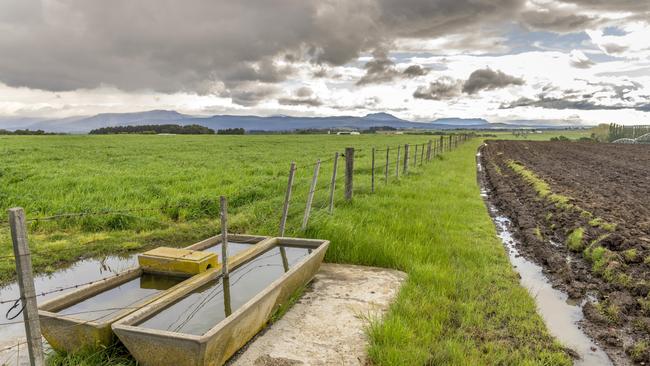
“It landed left wheel first, then right wheel, but because I was coming in too fast and I hit the ground a lot harder than I would normally land, the plane’s taken off again. It’s bounced back up and started flying again. I’d been going about 80km/h.
“The other thing that happened when I hit the ground was the airflow dropped and the flames completely engulfed the cabin. It was unbearable.
“I forced the plane back down again and we hit the ground but it bounced again and started taking off a second time.
“That’s when I told myself, ‘Anywhere is better than being in here.’
“I undid the seatbelt and threw myself out of the aircraft. I grabbed the door and pulled myself out – dived head first. I know I hit the wheel as I went down and there was a strut in the way, so I knocked a couple of things as I went out, and then I just remember hitting the grass and rolling.
“I would have fallen two, three, maybe even four metres. It wasn’t significant. I didn’t break anything. I was lucky in the sense that the grass was so thick and lush, it broke the fall and absorbed a lot of the speed when I was rolling. So it wasn’t as if I was hitting hard concrete, rolling, smashing on concrete.
“The grass looked after me a bit.’’

A CRY FOR HELP
Hopkins survived the impact without a broken bone. But he was horribly burnt, and did not know where he was.
“I had to go into first-aid mode and I remembered with burns, you’ve got to get them wet and cool them down,’’ he wrote.
“The grass had some dew on it so I thought I’d roll in that and get soaked … but it was not enough. So I thought I’d better get some help.
“I knew my phone was in my flight bag which had been sitting on the passenger seat … but the cabin was just completely ablaze, I couldn’t even get close to it.
“I had a personal locator beacon on the cabin wall in the cockpit, but obviously I couldn’t get to that either.
“So I thought I’d go the old-fashioned way for help, which was to yell out as loud as I could: ‘Help! Help!’
“I hoped someone might hear me. But then I thought, ‘It’s a Sunday, people are going to be away; it’s a weekend, most likely no one’s going to be home’.
“But I had nothing to lose, so I picked what I thought was the closest house and started walking along the fence line towards it, calling for help as I went. I was hoping someone might hear, but I realised I was probably half a kilometre or more from any houses.
“As it turned out, it was a nice still day and they could hear me. My voice was travelling.
“I saw a concrete water trough that was straddling the fence line. So I went into the water. I couldn’t fit all of me in there but I sort of squatted and got the legs in, bit of my bum, and used my hands to scoop water over myself.
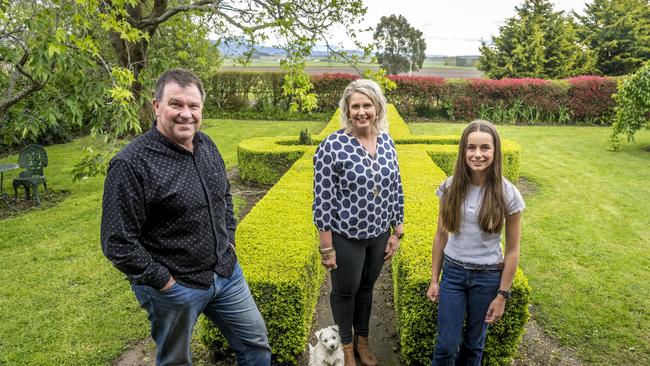
“I knew my face was burnt, I was hot, over my arms, shoulders, the whole lot. I was still dressed but I could see the sleeve on my right side had all been melted off. I’d had a bushwalking shirt made of quick-dry fabric and it had all melted, along with the high-vis vest I’d had on.
“I could see my hand had been sort of de-gloved; the right-hand skin had all peeled off and was hanging down. All the skin had peeled off and was missing on my left hand and it was badly burnt. I’m not sure how the left hand got so burnt, given it was out of the plane holding the door, but it did. My hands were black.
“I looked at my right leg and could see from the knee to the ankle it was really, really white. It was like chicken that had been cooked and gone white. It was weird. Apparently that was deep tissue burn and the skin had been torn off.
“The pain was starting to build at that point but it was not excruciating, because all the nerves had been burned off, and the adrenaline was still pumping as well. It’s hard to describe. I was hurting. I knew I was in trouble. But it wasn’t unbearable pain – that came later.
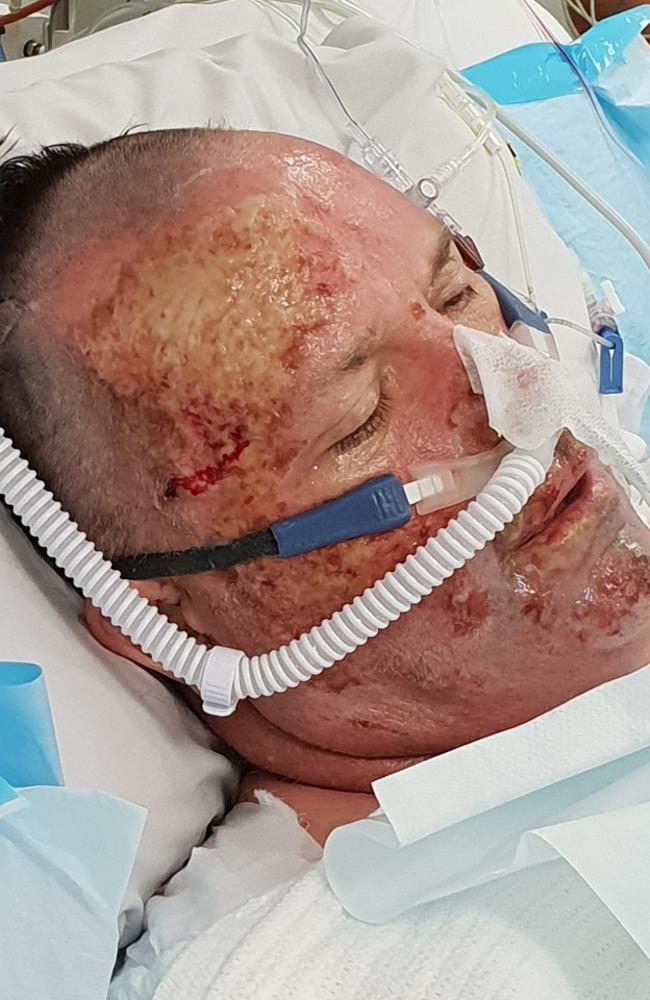
“As I was splashing water on myself, I realised I was getting electric shocks. They were coming through the trough. Turned out when the plane went through the fence, it shorted out the entire electric fence.
“Then I noticed I was scooping rice all over me. I could see I was putting it all over my hair and these grains of rice were running down my top and into the water. And I remember thinking ‘Where the hell does rice come from? Why would they have it in the trough?’ It was a mystery.
“Then I realised the rice wasn’t rice at all, but maggots. Something had died and there was a rotting carcass at the bottom of the trough and these maggots were coming off that. I was really concerned about these stupid maggots.
“Then I saw a white 4WD coming down from the house I had been walking towards and felt an overwhelming sense of relief. Help was coming.
“The vehicle was on the other side of the fence but heading directly to me.
“I was already lucky that day. But my luck hadn’t run out yet. The person who saved me was Toni Kilby, an emergency nurse at the Launceston General Hospital. She was with her daughter, Meg, who was 11 going on 26.’’

RIGHT PLACE, RIGHT TIME
Toni Kilby was spraying weeds outside her house with Meg when she heard noises she first dismissed as restless cattle.
Married to third-generation farmer Chris Kilby, she’d worked as an emergency department nurse for more than 20 years, and was enjoying a day off pottering in her garden when Hopkins crashed onto the farm, not far from Launceston Airport.
Realising the noises were a human voice calling for help, she jumped into the car with Meg, heading down through the paddocks to where she could see a plume of black oily smoke. Then she saw a blackened figure waving at her from the far corner of the paddock.
“I was quite concerned because all I could see was he was all black, with soot, smoke, and he was just burnt, everything was just sort of burnt off him,’’ Kilby said.
“The skin was just sort of dropping off him. All his hands and his arms. And his shorts were burnt to his legs. He didn’t have any hair at all, it had all been singed off.
“So I was very worried about airway burns; that was my biggest worry when I got to him. I could see the burns everywhere else, but the airways are the biggest things we worry about at work.’’
Dialling triple-0, she was able to give them the information they needed to send multiple ambulances equipped to intubate Hopkins if his airways closed over from the burns.
Young Meg bravely struggled to open the now-electrified gate, and the pair rushed to Hopkins, who had climbed back into the trough.
Meg ignored repeated electric shocks to use a Tupperware container to pour water over Hopkins, who kept apologising to the youngster for the way he looked, worried he was traumatising her.
“I felt bad for Meg, because she had all that thrown in her face; I must have looked like a horror movie, but she didn’t flinch, she did everything her Mum told her to do and she was a real trooper. She’s a great little girl, that one,’’ Hopkins said.
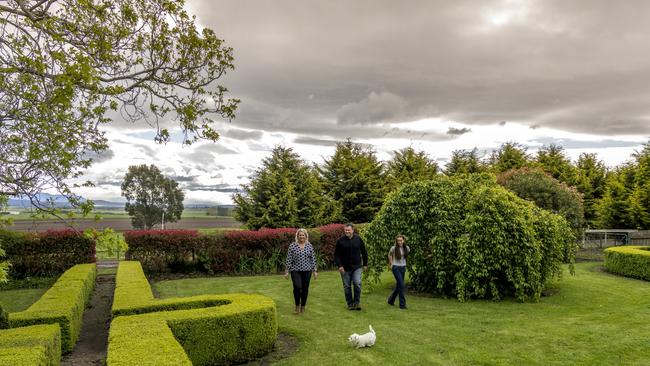
Moving Hopkins to a cleaner trough with deeper water, Kilby stripped the burnt outer layers of his clothes off, then helped him into the car and drove to a woodshed where she sprayed him with a hose, desperately trying to cool the burns.
“I’ve seen quite a few burns in my time, so I knew what to do and I knew how bad it was,’’ she said. “I was really worried about his airway. We kept talking and I kept asking ‘does your throat feel tight, are there any problems breathing?’
“He said ‘no, no, no, no’. It was fantastic. He held his airway beautifully the whole time, thank God.”
Three ambulances soon arrived, along with firefighters and police, all directed along narrow farm lanes by Kilby’s son, Harry.
Hopkins remained calm throughout the ordeal and borrowed Kilby’s mobile phone to call the police radio room to report his own accident.
“I remember when they got there, Toni told me she was a nurse. I knew she would know what to do,’’ Hopkins said.
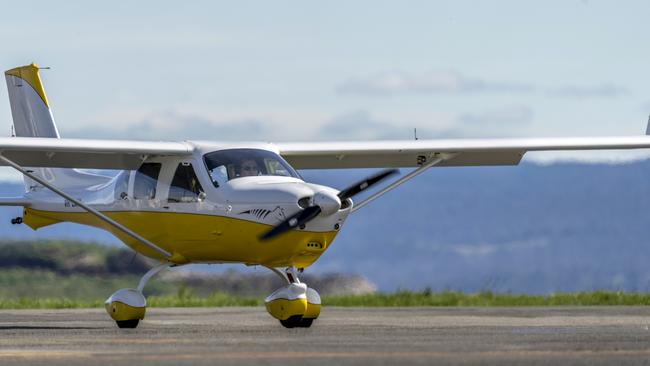
“She said what I had done was right. I told her about the maggots and she said ‘don’t worry about them: we’ll deal with infection later’.
“She said I needed to get my clothes off. I stood up, got out of the trough and took off what was left of my shirt and vest, the jean shorts I’d been wearing, my socks. I had one shoe on and we never found the other one, I must have knocked it off when I was rolling. Toni let me keep my undies on.
“Toni said she’d called an ambulance. I asked if I could call work. I used her mobile and I called the police radio room in Hobart, the supervisor’s direct line, and told them who I was, what had happened, my aircraft registration.
“I thought I was in a really remote area, not close to roads; I had no idea where I was other than the general area.
“We walked towards the car and Toni’s plan was to get me to her mother-in-law’s place. They’re the owners of the farm there.
“When I’d been shot staking out a drug crop 20-odd years earlier, I remember being carried out on a stretcher and my hands dragging through stinging nettles. This time, I was walking with bare feet and I was walking on prickles. Bloody prickles. I thought ‘What is it about me being injured and foliage killing me again?’ I remember walking on those bloody prickles and it hurt, so I had some sensation in my feet.
“When we got to the house, Toni made me stand near a tap out in the back yard area, a farm work area, and she got a hose and started hosing me down.
“I started getting cold, bitterly cold. Toni reckons that’s when I started going into shock.
“As I understand it, Toni called for three separate ambulances, because the first couple wouldn’t have come with the drugs she knew that I would need straight away. She obviously appreciated the fact that if I didn’t get that care quickly, I would die. And that’s why she wanted a paramedic with all the right equipment and drugs, to intubate me and take over my breathing as soon as possible.

“I didn’t know but apparently when you’re burned that badly, your body starts to swell up with water and you can choke with it. They had to slice my arms and legs open literally like sausages – if they hadn’t done that, I would have potentially lost my limbs.
“I saw Chris Rockliff, one of the search and rescue guys from Westbury station. They were getting me to walk towards the stretcher and I said ‘G’day Rocky, how’re you going?’ And he looked at me and – I found out later – he didn’t recognise me at all, and I’ve known him for years. He was trying to work out who I might be.
“I remember lying on the stretcher. I felt bad getting it all wet because I was soaking wet but got on it anyway. As I laid down, Toni apparently said, ‘Don’t worry, Darren, everything’s going to be OK’. And Rocky’s thinking, so he told me, ‘Darren who owns a plane, who the hell is Darren who owns a plane that I know?’ And then he put two and two together and realised it was me.
“I knew I looked bad and skin was hanging off and bits of me were missing. I didn’t know what my face looked like, but apparently I was unrecognisable to a guy who’s known me for years.
“I didn’t appreciate how badly burnt I was and how much time it takes to recover. I certainly didn’t think I’d end up in a coma for nearly two weeks and in hospital for months.
“And I didn’t know that landing that burning plane was only the start of my battle to stay alive.’’
THE FIGHT OF HIS LIFE
Given strong doses of pain medication, and going into shock, he has no recollection of leaving the farm, being taken to the Launceston General Hospital, then being transferred to the Royal Hobart Hospital by helicopter, where he was placed in a coma for 11 days.
He credits Royal Hobart Hospital’s intensive care unit and Tasmanian Burns Unit for his miraculous recovery, particularly plastic and reconstructive surgeon Andrew Castley and burns nurse Rebecca Schrale.
“On the bad days when things were going wrong, Bec would say, ‘oh it’s fine, Darren, we’ve just got to do this, we will fix it with that, don’t worry’ and it really helped,’’ he said.
“Andrew is … very quiet and reserved but very confident about what he was doing and he would tell me straight: “We just can’t fix that, Darren, it’s either take the finger off or we’re going to have to put in a metal rod between the joints to keep it from falling off.’’
Castley said Hopkins had significant burns to 40 per cent of his body; a number of the burns were full thickness.
He underwent a range of treatments, including a relatively new treatment for burns patients known as BTM, or biodegradable temporising matrix, followed by skin grafts six weeks later.
“I was always struck by Darren’s positive attitude and his keenness to make the best of a bad situation,’’ Castley said.
“I think this has certainly aided in his good outcome. Milestones such as leaving hospital are always memorable, but more long-term functional moments like getting home from rehab or returning to work are also good days.
“It shows that the patients are returning to some normality in their lives, which is always good for their psychological health. It shows that all the hard work done by the patient and the burns team has paid off.’
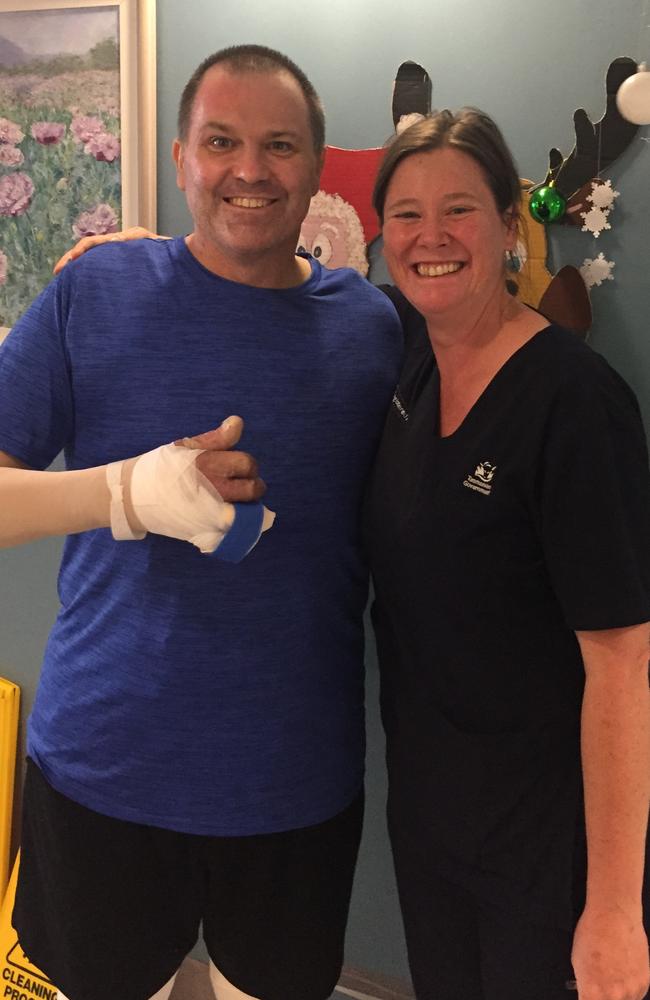
Schrale said she first saw Hopkins the morning after he was flown to the burns unit.
“Darren had burns to his face and evidence of burns in his upper airways from breathing in soot and hot gases – including potential smoke inhalation from the fire in the cockpit of the plane,’’ she said. “He required intubation to protect his airways and assist with breathing, as facial burns become very swollen post injury and can affect the person’s ability to breath.’’
Schrale, who has 20 years’ experience as a burns nurse, said she was always confident Hopkins would survive, and return to most, if not all, of his previous life activities.
“Darren was always such a great patient to work with,’’ she said. “His commitment to his recovery and to his family was always present.
“He continues to see us as an outpatient for regular reviews and has also joined the Burns Registry of Australia and New Zealand as a consumer representative. Darren has recently started … sharing his experience with clinicians that are new to burns – this has been incredibly helpful to provide insight into the patient’s experience and how we can continue to improve our care in this area.’’
Kilby and Meg were among Hopkins’ visitors in the months he spent in hospital.
“To basically fall into the lap of an emergency nurse, I couldn’t have picked any better,” Hopkins said.
“I was very lucky with that, very grateful that they were there firstly, a very welcoming sight to see them driving towards me.’’
The same determination he showed in landing the plane was obvious in the hospital, where one surgeon dubbed him Wolverine, testament to his remarkable recovery.
“He said I was healing right before his eyes,’’ Hopkins said.
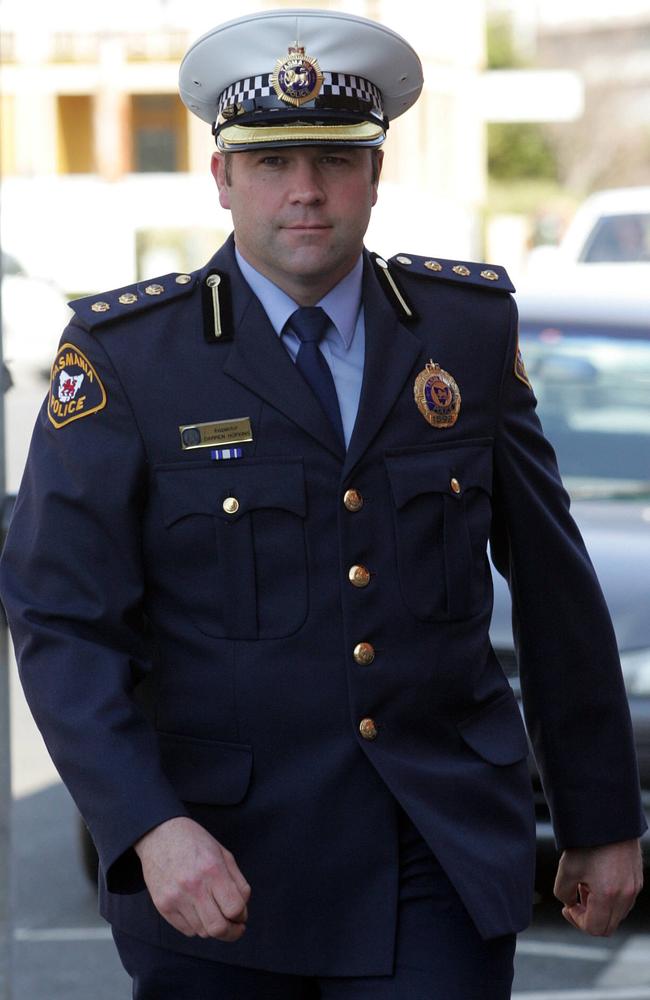
FAMILY, FRIENDS AND FLYING
Hopkins was released from hospital at Christmas in 2018, and on March 10, 2019, was back at work part-time, although says in hindsight he should have taken longer to adjust and regain physically and emotional strength.
He was wearing pressure bandages and was required to undergo more surgery, particularly on his badly burned fingers and hands, as well as recover from multiple skin grafts.
“There’s pretty much not a part of me that they haven’t peeled or scraped. Wherever the burns weren’t, they’ve taken grafts,’’ he said.
Hopkins escaped death in 1996 when he was blasted at close range with a shotgun while raiding a drug drop, and had extensive scarring on his back. He jokes that due to his grafts, those scars are now “probably spread all over my legs’’.

On secondment as the regional manager for the State Emergency Service, his usual job is in charge of District Support Services at police headquarters in Launceston. He works full-time, and supports long-term injured or unwell police officers, encouraging their return to work.
Despite the relentless pain and the physical and mental scarring, the past three years have seen some positives. Hopkins married his long-term partner, Michelle, in front of family and friends in Thailand two years ago. “That was another good milestone,’’ he said.
The Kilbys and Hopkins became friends through the ordeal, and the two families have anniversary dinners together to mark the day they met. Hopkins and Kilby also meet regularly for coffee.

“The paddock he had landed in was rye grass, being grown for hay,’’ Kilby said.
“It was just lush, green grass, more than a foot high, probably the best paddock he could have landed in. Chris quite often stirs Darren now about wrecking his grass crop. “
Hopkins said the accident had taught him to “live it now as if it’s the last day and appreciate it’’.
“It certainly taught me the appreciation of family and friends, particularly over work. We prioritise our work more than we should. Family’s the most important, followed by your friends. They’re the ones who are there by your side the whole time, and always will be,’’ he said.
Hopkins this week took possession of a new Jabiru, saying he has a “lot of faith’’ in the company and their aircraft. He also has a new personal locator beacon that he carries in his pocket when he flies, as pilot or passenger.
“You don’t know when an accident is coming, so whether it’s bushwalking or boating or flying, keep it close at all times,’’ he said.
Kilby said “everything came together’’ on the day of Hopkins’ crash.
“I was part of saving his life. Not the whole part. I was just in the right place at the right time,’’ Kilby said.
“Then there’s the sort of person that he is – being calm and being such a fighter and so resilient. He is such a strong personality, he wants to get better.
“He is the driving force in his recovery and he’s amazing.’’

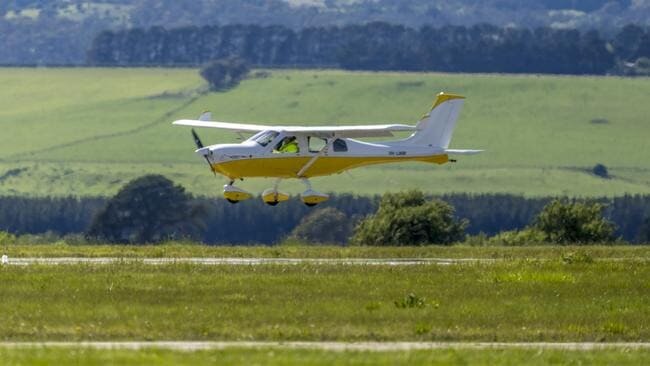
Major changes to Aussie laws: What you need to know
Major changes are set to roll out across Australia from July 1, including wage hikes, new parental leave and tougher road rules. See how it will affect you.
Huge change to impact your electricity bill
A major change is coming to how many times energy retailers can increase electricity prices on Aussies.